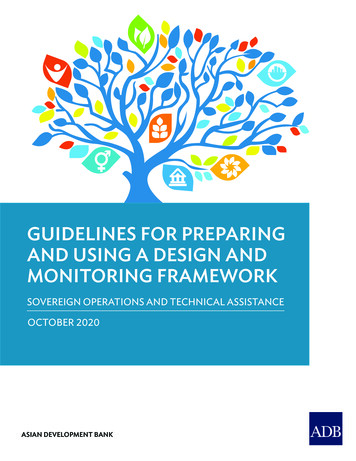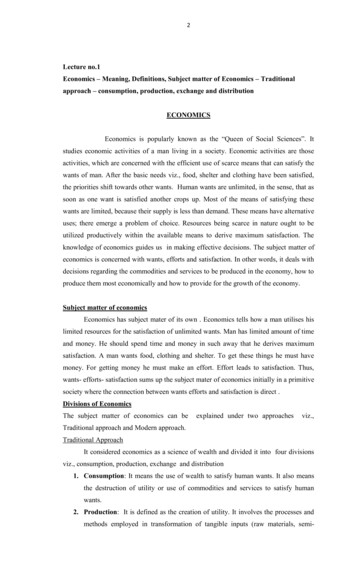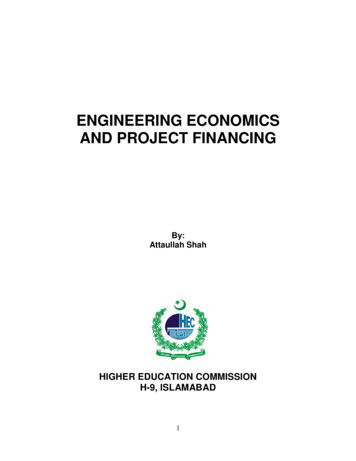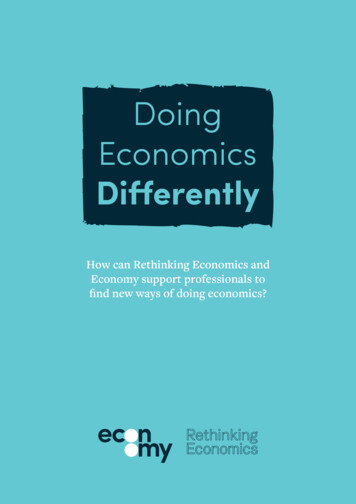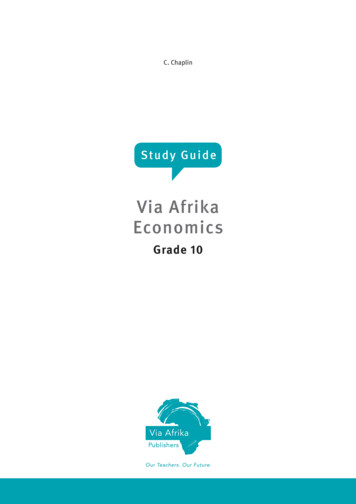
Transcription
ADB EconomicsWorking Paper SeriesFinancial Development and EconomicGrowth in Developing AsiaGemma Estrada, Donghyun Park, and Arief RamayandiNo. 233 November 2010
ADB Economics Working Paper Series No. 233Financial Development and EconomicGrowth in Developing AsiaGemma Estrada, Donghyun Park, and Arief RamayandiNovember 2010Gemma Estrada is Economics Officer; Donghyun Park is Principal Economist; and Arief Ramayandi isEconomist in the Macroeconomics and Finance Research Division, Economics and Research Department,Asian Development Bank (ADB). The authors gratefully acknowledge the valuable comments of CharlesAdams and participants at the ADB Workshop on Pushing Developing Asia’s Frontier Forward: SustainingGrowth Beyond the Crisis, held 20 July 2010 at ADB Headquarters, Manila, Philippines. The authorsaccept responsibility for any errors in the paper.
Asian Development Bank6 ADB Avenue, Mandaluyong City1550 Metro Manila, Philippineswww.adb.org/economics 2010 by Asian Development BankNovember 2010ISSN 1655-5252Publication Stock No. WPS112898The views expressed in this paperare those of the author(s) and do notnecessarily reflect the views or policiesof the Asian Development Bank.The ADB Economics Working Paper Series is a forum for stimulating discussion andeliciting feedback on ongoing and recently completed research and policy studiesundertaken by the Asian Development Bank (ADB) staff, consultants, or resourcepersons. The series deals with key economic and development problems, particularlythose facing the Asia and Pacific region; as well as conceptual, analytical, ormethodological issues relating to project/program economic analysis, and statistical dataand measurement. The series aims to enhance the knowledge on Asia’s developmentand policy challenges; strengthen analytical rigor and quality of ADB’s country partnershipstrategies, and its subregional and country operations; and improve the quality andavailability of statistical data and development indicators for monitoring developmenteffectiveness.The ADB Economics Working Paper Series is a quick-disseminating, informal publicationwhose titles could subsequently be revised for publication as articles in professionaljournals or chapters in books. The series is maintained by the Economics and ResearchDepartment.
ContentsAbstractvI.Introduction1II.Does Financial Development Promote Growth? Theory and Evidence4A.B.47III.Developing Asia’s Financial Development: Some Stylized FactsA.B.C.D.IV.V.Financial Development and Growth: TheoryFinancial Development and Growth: EvidenceComparison of Financial Depth in Developing Asia versus OECDFinancial Depth, Breadth, and Access in Developing AsiaCorrelation Between Developing Asia’s Financial Developmentand GrowthOverall Summary of Stylized Facts1010111618Empirical Analysis of the Finance–Growth Relationship18A.B.C.192142Model and DataEmpirical ResultsOverall Summary of Empirical ResultsConcluding Observations and Policy Implications42Appendix 1: List of Economies and Number of ObservationsAppendix 2: Definition of Variables and Their Data Sources5053References54
AbstractEconomic theory suggests that sound and efficient financial systems—banks,equity markets, and bond markets—which channel capital to its most productiveuses are beneficial for economic growth. Sound and efficient financial systemsare especially important for sustaining growth in developing Asia becauseefficiency of investment will overshadow quantity of investment as the driverof growth in the region. The data indicate that the region’s financial systemshave become deeper and more diversified since the early 1990s. A more formaleconometric analysis on a panel data of 125 countries confirms that financialdevelopment has a significant positive effect on growth, especially in developingcountries. The results also indicate that the impact of financial development onthe region’s growth is not noticeably different than elsewhere, and the impacthas weakened since the Asian financial crisis. Overall, our evidence supportsthe notion that further development of the financial sector matters for sustainingdeveloping Asia’s growth in the postcrisis period. However, the primary role offinancial sector development in growth is likely to shift away from mobilizingsavings, thus augmenting the quantity of investment toward improving theefficiency of investment, and thereby contributing to higher economywideproductivity.
I. IntroductionWhile there were a number of factors underlying the global financial and economic crisis,the crisis was most immediately the consequence of market failures in the housing andfinancial markets in the United States (US). The development of sophisticated financialderivatives purportedly allowed for an efficient transfer of risk to those best able to bear it.In practice, however, such instruments can potentially obscure the true magnitude of thehuge systemic risk inherent in the financial system arising from massive lending to homebuyers with subprime credit ratings. The speed and scope of such financial innovationoften far outpaced the capacity of the regulatory authorities to keep up. As a result,existing prudential regulation and supervision repeatedly failed to contain excessiverisk taking behavior of the market participants. The recent global crisis represents thiscolossal failure of prudential regulation and supervision. Predictably and understandably,there has been something of a global backlash against financial innovation and financein general in the aftermath of the global crisis. Finance has come to be associated withcrisis, credit crunch, and recession, rather than as a lubricant of growth and development.Developing Asia’s financial systems have largely escaped the paralysis experienced bytheir counterparts in the European Union (EU) and the US during the global financialcrisis. Even during the climax of the crisis, credit flowed more or less normally fromthe financial system to the real economy. In particular, commercial banks, the bedrockof the region’s financial system, continue to provide financing for the region’s firmsand households. The region was not completely free from financial instability but thebouts of instability were intermittent and sporadic rather than systematic and persistent.For example, the Republic of Korea’s financial markets suffered severe turbulence inOctober 2008, but they soon regained their footing after the Bank of Korea entered intoswap deals with the US Federal Reserve, the Bank of Japan, and the People’s Bank ofChina. In fact, the primary impact of the global financial crisis on developing Asia wasnot financial at all but transmitted through the trade channel, as the recession in theindustrialized countries dulled their appetite for the region’s exports. A major explanationfor why the region’s financial systems were largely unscathed by the momentousupheaval in the global financial markets was that the region’s financial institutions hadvery low levels of direct and indirect exposure to subprime assets such as mortgagebacked securities and collateralized debt obligations. The lack of exposure to toxic assets,in turn, is widely believed to have been due to the relative lack of financial sophistication.As the global crisis has painfully highlighted, the failure of financial regulatory authoritiesto monitor and control the risks associated with financial innovation can be a major
2 ADB Economics Working Paper Series No. 233source of instability for the financial system and the real economy. Subject to adequateprudential supervision, financial innovation can promote the soundness and efficiency offinancial markets. The concept of financial innovation, in the sense of complex, opaque,and poorly understood financial instruments associated with the global crisis, shouldnot be equated with the broader and more basic concept of financial development,which refers to the development of a broad, deep, and liquid financial system thatefficiently intermediates the economy’s savings into various productive uses, in particularinvestment. Indeed, a number of constructive financial innovations developed in the pasthave substantially eased payment transactions, encouraged savings, helped channelsavings into productive investments, and facilitated allocation of financial risks (Litan2010).Financial systems in developing Asia remain far below industrial-country standards andlag substantially behind its dynamic real economy particularly the manufacturing sector,which is world-class in many parts. This explains why much of the region’s huge poolof savings is intermediated by financially more advanced economies outside the region.Financial development for a financially underdeveloped region such as developing Asiarefers to the basic business of building up sounder and more efficient banks, equitymarkets, and bond markets.If financial underdevelopment allowed developing Asia to fortuitously escape the globalfinancial crisis, the Asian financial crisis of 1997–1998 underlines the potentially largecosts of financial underdevelopment. A wide range of underlying factors contributed to thecrisis, and to this debate, the relative importance of the different factors remains a subjectof heated controversy. While the reversal of large inflows of volatile short-term foreigncapital was the immediate catalyst of the crisis, weak and inefficient financial systemsthat failed to allocate capital to productive uses lay at the heart of the crisis. Much ofthe credit flowed into investments that failed to add to the productive capacity of theeconomy, hence its debt repayment capacity, most notably real estate. The Asian crisiswas ultimately the consequence of a gradual deterioration in the quality of investmentswhich, in turn, resulted from large capital inflows into underdeveloped financial systemsthat could not allocate them efficiently. For a region that had grown rapidly on the backof high investment rates, the Asian crisis served as a sobering view that the quality ofinvestment matters, and matters a lot.Fortunately, developing Asia has made a great deal of progress in building up a morerobust and efficient financial system since the Asian crisis as a result of extensivepostcrisis reform and restructuring. In particular, the health of Asia’s commercial banks,which continue to play a dominant role in Asian financial systems, has improvedmarkedly. This improvement is reflected in the incidence of nonperforming loans, capitaladequacy ratios, rates of return on assets, and other major performance indicators.According to Adams (2008), key changes in Asian banking sectors include consolidationand rationalization, greater transparency and disclosure, increase in foreign ownership,
Financial Development and Economic Growth in Developing Asia 3and decline in state ownership. Asian banks have built up sizable prudential cushionsas a result of new capital injections, and their balance sheets have generally becomestronger. They have also moved into new business areas such as investment banking,consumer lending, and real estate, in addition to providing a wider range of financialproducts and services. Furthermore, in most countries, the prudential supervision andregulation structures have been strengthened, and have become more forwardlooking andrisk-based. In addition to the improvement in the health of the banking system, anotherpositive recent development in developing Asia’s financial systems has been the rapiddevelopment of equity markets, and to a lesser, extent bond markets. A more diversefinancial system that is less dependent on banks is more robust and resilient to shocks.More importantly, vibrant capital markets are the primary source of long-term capital thatfinances an economy’s long-term investment needs.Sound and efficient financial systems that do a good job of their primary function ofallocating capital to its most productive uses will be pivotal to sustaining growth beyondthe crisis for one simple fundamental reason—developing Asia needs healthy investmentfor strong medium- and long-term growth. In the past, the primary contribution of thefinancial system to the region’s growth has been to mobilize large pools of savings thatwere then used to finance the region’s plethora of profitable investment opportunities.In the past, developing Asia was a low-income, capital-scarce region with inherentlyhigh marginal returns to capital. Therefore, in the context of growth, the efficiency ofinvestment was secondary to the quantity of investment as the economies built up theircapital stocks from very low initial bases. Rapid growth has transformed developing Asiainto a middle-income, capital-abundant region. As a result, the region is in the midst ofa transition from growth based on inputs and factor accumulation, to growth based onproductivity growth (Park and Park 2010). Therefore, the primary role of the financialsystem in the region’s growth is likely to change from that of mobilizing savings andboosting the quantity of investment to fostering productivity growth by enhancing theefficiency of investment. Such a role requires deeper, broader, and more liquid financialsystems that move the region closer toward the frontier of global finance. Expandingfinancial access to small and medium enterprises (SMEs) and would-be entrepreneurs isvital for dynamic efficiency in which new products, services, and industries bring aboutstructural change and deliver large welfare gains over time. Expanded access alsofacilitates the entry of new producers into the market and thereby stimulates a competitiveenvironment conducive for productivity growth.The primary role of the financial system in developing Asia’s economic growth in thepostglobal crisis period will thus be to improve the efficiency of investment, therebycontributing to productivity growth. The underlying rationale is the region’s broadertransition from accumulation-led growth to productivity-led growth. In addition to thisstructural shift in developing Asia’s growth process, there are also a number of otherfactors that suggest a key role for a sound and efficient financial system in sustainingthe region’s growth beyond the global crisis. For one, reducing excessive dependence
4 ADB Economics Working Paper Series No. 233on extraregional markets and rebalancing growth toward domestic sources hasemerged as a key structural challenge confronting the region. Financial developmentcan promote rebalancing by stimulating domestic consumption on the demand sideand service industries catering to domestic demand on the supply side. One mediumterm rationale for strengthening the financial systems is the prospect of large capitalinflows attracted to the region’s stronger growth prospects, and higher interest ratesvis-à-vis the industrialized countries. While capital controls are one way to deal withcapital inflows, a more fundamental solution lies in increasing the absorptive capacityof the financial system. A long-term rationale for sounder and more efficient financialsystems is the region’s rapid population ageing, which will reduce aggregate savings inthe future. Again, this points to a growing need to improve the efficiency of investment.Financial development will also allow the region’s financial institutions to play a greaterrole in intermediating the region’s large pool of net savings accumulated from pastexternal surpluses. Currently, the vast majority of those savings are intermediated by thegovernment in the form of foreign exchange reserves.II. Does Financial Development Promote Growth?Theory and EvidenceIn this section, we review the main theoretical rationales for a positive effect of financialdevelopment on economic growth and provide a brief overview of the large and growingempirical literature that investigates the financial development–growth nexus.A.Financial Development and Growth: TheoryA financial system consists of financial institutions—e.g., commercial banks—andfinancial markets—e.g., stock and bond markets. At a broader level, a robust and efficientfinancial system promotes growth by channeling resources to their most productive usesand fostering a more efficient allocation of resources. A stronger and better financialsystem can also lift growth by boosting the aggregate savings rate and investmentrate, speeding up the accumulation of physical capital. Financial development alsopromotes growth by strengthening competition and stimulating innovative activities thatfoster dynamic efficiency. According to Demirgüç-Kunt and Levine (2008), the overallfunction of a financial system is to reduce information and transactions costs impedingeconomic activity, and its five core functions are to (i) produce ex ante informationabout possible investments and allocate capital; (ii) monitor investments and providecorporate governance after providing finance; (iii) facilitate the trading, diversification andmanagement of risk; (iv) mobilize and pool savings; and (v) ease the exchange of goodsand services. The efficiency of a financial system refers to how well a financial systemperforms the five core functions and financial development refers to an improvement
Financial Development and Economic Growth in Developing Asia 5in the efficiency of a financial system. Let us now elaborate upon each of the fivecore functions so as to gain a clearer understanding of the nexus between financialdevelopment and economic growth.First and foremost, financial systems produce information and allocate capital. Thetextbook world of scarce capital seamlessly flowing to the most productive firms andindustries is a world that assumes away information costs. The intermediation of savingsinto investments depends on the quality and quantity of information available to individualsavers, but it may be too costly individual savers to acquire information on their own.Financial intermediaries such as banks collect, process, and produce information onpossible investments more efficiently than individual savers. Armed with more and betterinformation, financial intermediaries will invest in more promising firms and industries.The economywide effect is a more efficient allocation of capital that directs capital towardthe more productive producers and away from the less productive producers. Financialintermediaries can also stimulate innovation by identifying the most promising newtechnologies and products. Large and liquid stock markets also encourage the acquisitionof information by making firm-specific information more profitable.Second, financial systems monitor firm behavior and exert corporate governance. Tothe extent that shareholders and creditors in a firm can effectively monitor and influencehow the managers of the firm use the funds they provided, i.e., exercise corporategovernance, they will have greater incentive to provide the funds in the first place.Effective corporate governance keeps managers on their toes and encourages them touse capital in ways that maximize profits and firm value. More efficient management atthe firm level results in a more efficient allocation of resources for the economy as awhole. Large information and transactions costs mean that small individual shareholdersand creditors do not have the incentive to engage in monitoring manager behavior.On the other hand, larger investors such as financial intermediaries face strongerincentives to monitor and have greater influence over managers. By improving corporategovernance, financial intermediaries can have a positive effect on growth. Stock marketscan also serve as a powerful for aligning the interests of firm mangers with those of firmowners.Third, financial instruments, intermediaries, and markets can facilitate the trading,hedging, and pooling of risk. By enabling risk diversification across firms and industries,financial systems can influence the allocation of resources and hence economic growth.While individuals are generally averse to risk, high-return investment opportunities tendto be high-risk. By allowing individuals to diversify their risk, financial intermediaries andmarkets divert more capital to high-risk, high-return investment projects and therebyboost the overall productivity of capital. Risk diversification also has a positive impact oninnovative activity since risk-averse savers are more likely to invest in a portfolio of newtechnologies and products than a single new technology or product. Financial marketsand intermediaries also mitigate liquidity risk, and thereby induce savers to invest in
6 ADB Economics Working Paper Series No. 233high-return projects requiring a long-term commitment of capital. Highly liquid marketsfor stocks, bonds, and demand deposits transform these financial instruments intoinvestments and into high-return, long-term projects.Fourth, financial systems pool or mobilize savings from different savers for investment.The mobilization of savings involves collecting savings from a large number of individualsinto collectively large amounts that can finance even very large investment projects. Bothfinancial intermediaries and financial markets can perform this function. Financial systemsthat are better able to mobilize savings create a larger pool of savings that lead to higheraggregate investment, faster rate of capital accumulation, and hence faster economicgrowth. Given that one of the hallmarks of developing Asia’s economic success was itshigh saving and investment rates, this core function has been important for the region’sgrowth in the past. More generally, the mobilization of savings for investment mattersmore for low-income, capital-scarce economies, which typically enjoy higher marginalreturns to capital. The high relative importance of the savings mobilizing function offinancial systems at low income levels mirrors the high relative importance of quantitativecapital accumulation in the early stages of the growth process.Fifth, at a more fundamental level, financial instruments, intermediaries, and marketscan stimulate specialization, innovation, and growth by reducing transactions costs. Thetransition from barter economy to a monetary economy brings about a quantum leapin efficiency and welfare as a result of the three basic functions of money—means ofpayment, unit of account, and store. By reducing the transactions costs of economicexchange and activity, money enables workers to specialize in specific activities. Greaterspecialization, in turn, improves the capacity of workers to create new technologies andproducts. The end result of increased specialization and innovation is faster economicgrowth. The decline in transactions costs does not stop with the introduction of money butwill continue as long as there is financial innovation. Credit cards and automated tellermachines are but two examples of financial innovation that have cut transactions costs.Financial innovation that reduces the cost of economic exchange and activity will spurfurther specialization and innovation and thereby contribute to growth.In the case of developing countries, including developing Asia, stability or lack thereof ofthe financial system is another channel through which financial development influencesgrowth. A sound financial system is characterized by healthy financial institutionsand smooth, well-functioning financial markets, which jointly allow for robustness andresilience in the face of adverse shocks. For example, as noted earlier, the balancesheets of developing Asia’s banks have become markedly stronger since the Asian crisisas a result of consolidation, recapitalization, and more generally, restructuring and reform.Likewise, sound equity and bond markets are markets with enough size, breadth, depth,liquidity, and sophistication so that their movements are broadly in line with fundamentalsrather than subject to excessive noise and volatility. An effective prudential regulatory andsupervisory framework, along with the risk management capacity of banks and sound
Financial Development and Economic Growth in Developing Asia 7market infrastructure of the bond and equity markets, holds the key to ensuring stabilityof the financial sector. Developing Asia would have suffered a much steeper declinein growth had it suffered the same level of financial instability experienced by the EUand the US during the global financial crisis. Furthermore, during the Asian crisis manycountries in the region were firsthand witnesses to the devastating impact of financialinstability on the real economy. Therefore, in the context of fostering growth, an integralcomponent of developing Asia’s financial development must be to build up robust andresilient financial systems capable of withstanding even large shocks.Another dimension of financial development that has a special resonance for developingAsia and other developing countries is access to financial services. Relative toindustrialized countries, the access of firms and households in those countries remainslimited. Lack of access to finance can be a serious barrier to investment and businessactivity in general. In particular, lack of new financing often impedes setting up newbusinesses essential to a dynamic economy. New firms are especially important inknowledge-based industries that will grow in significance as the region’s economiesmature. More generally, entrepreneurship is essential for a vibrant private sector thatconstantly renews itself and creates new firms, industries, and jobs, for which accessto finance is the indispensable lubricant for entrepreneurship. Adequate financing forSMEs, which tend to predominate in the services sector, will help revitalize the region’sservices sector that has lagged its manufacturing sector for a long time. Access tofinance, whether through mainstream financial institutions or through microfinance andother specialized institutions, can expand the opportunities for poorer households toengage in productive activities. For example, rural finance can provide rural householdswith the money to buy high-yield seeds, fertilizers, and farming equipment. Just asimportantly, access to finance confers substantial welfare gains for poorer households by,for example, allowing them to smooth their lifetime consumption and coping with negativeshocks. Therefore, access to finance can contribute to narrow economic growth as wellas broader social development.B.Financial Development and Growth: EvidenceEconomic theory and intuition suggest a number of plausible channels through whichfinancial development can have a positive effect on economic growth. Predictably, alarge and growing empirical literature has sprung up to examine the relationship betweenfinance and growth. At a broader level, the literature looks at the impact on grossdomestic product (GDP) growth of (i) the depth of the financial system, as measured byindicators such as the ratio of total liquid liabilities to GDP, the ratio of bank credit to GDP,or the ratio of stock market capitalization to GDP; and (ii) the structure of the financialsystem, as measured by indicators such as the ratio of bank credit to stock marketcapitalization. The balance of evidence from the empirical literature strongly indicates thatfinancial depth has a significant positive effect on growth whereas financial structure (therelative weight of banks versus capital markets) does not have any appreciable effect
8 ADB Economics Working Paper Series No. 233on growth. More specifically, bank development and stock market development exerts asignificant positive effect on growth, as does overall financial development. Although ashift from banks to capital markets is often viewed as evidence of financial development,countries with market-based financial systems do not perform better than those withbank-based systems. Therefore, the broader finding from the empirical literature is thatwhat matters for economic performance is overall financial development rather than therelative weight of its various components.In a comprehensive review of the empirical literature, Demirgüç-Kunt and Levine (2008)point out that the literature contains four different types of studies: (i) pure cross-countrygrowth regressions, (ii) panel techniques that make use of both the cross-country andtime-series dimensions of the data, (iii) microeconomic studies that explore the variouschannels through which finance may affect economic growth, and (iv) individual countrycase studies. The first approach involves the application of broad cross-country growthregressions, which seek to explain growth through standard explanatory variables suchas physical and human capital, to the study of finance and growth. These studies typicallyaggregate growth over long periods of time and examine the relationship betweenlong-run growth and various measures of financial development. The second approachinvolves the analysis of panel data and seeks to mitigate some of the econometricproblems associated with the pure cross-country approach. The second approach hasa number of well-known advantages vis-à-vis the first approach even though it alsosuffers from some disadvantages. The third approach uses firm-level and industry-leveldata to assess the impact of financial development on firm and industry performance. Apositive impact would lend support to the notion that financial development is beneficialfor growth. The fourth country drops the cross-country dimension and looks at the financegrowth in a single individual country. For example, some studies analyze the impact of aspecific policy change in a country.We now discuss in more detail the literature on cross-country growth regressions,including those that use panel techniques, since this is the approach we use for ourown empirical analysis. Empirical assessment of the relationship between growth andfinancial development involves a wide range of econometric techniques a
The ADB Economics Working Paper Series is a quick-disseminating, informal publication whose titles could subsequently be revised for publication as articles in professional journals or chapters in books. The series is maintained by the Economics and Research Department. Contents Abstract v I. Introduction 1 II. Does Financial Development .



